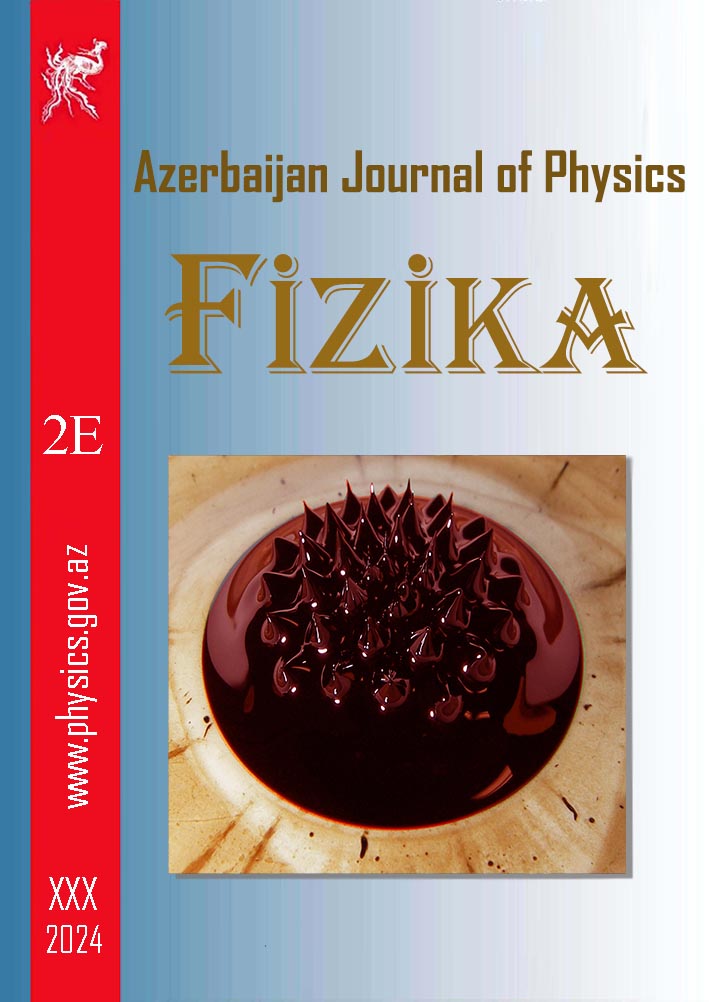ABSTRACT
The effect of electrothermopolarization on the surface density of electret charges and the relaxation time of the charge from the reciprocal temperature for a number of
nanocomposites based on PP and PE are studied. It is shown that the addition of a nanofiller (1% MnO2, 0.5% MnO2, 7% ZrO2,
2% TiO2, 1% PbCrO4) leads to an increase in the values of the electret potential difference of nanocomposites, and then decreases. This character of
the dependence is explained by a change in the physical structure of the boundary layer of the polymer matrix and a change in the interphase interaction on the strength of
the polarization field. The dependence of the charge relaxation time on the reciprocal temperature for all samples has approximately the same slope.
Keywords: nanocomposite, polyethylene, polypropylene, relaxation, electrothermopolarization.
PACS: 77.55
DOI:-
Received: 28.09.2021
AUTHORS & AFFILIATIONS
Institute of Physics of the National Academy of Sciences of Azerbaijan, Baku
E-mail: aem05@rambler.ru
|
REFERENCIES
[1] D.A. Rychkov. Stabilization of the charge of polymer electrets: monograph SPb.Publishing house of the Russian State Pedagogical University im. A.I. Herzen, 2013. p. 159.
[2] S.G. Boev. Charge injection into polymer dielectrics under corona discharge. Electret effect and electrical relaxation in solid dielectrics. Interuniversity collection. Moscow: Ed. MIEM, 1988. p. 71.
[3] Yu.A. Gorokhovatsky. Relaxation of the electret state in polyethylene-based polymeric fiber. Materials of the X International Conference "Physics of Dielectrics". SPb: Publishing house RSPU im.A.I. Herzen. 2004. p. 84-86.
[4] N.S. Enikolopov. Composite polymer materials Priroda, 1980, № 8, pp.62-67.
[5] M.A. Ramazanov, A.S. Quseynova, F.V. Hajiyeva. Influence of temperature and time regimes of crystallization and electrothermopolarization on the physical structures of polypropylene and MnO2-based composition Journal Optoelectronics and Advanced Materials., Rapid Communications v. 3 № 11- 2009, p. 1204-1206.
[6] A.M. Magerramov, M.A. Ramazanov, F.V. Gadzhieva, S.G. Alieva. The effect of the temperature-time mode of crystallization on the morphology and properties of nanocomposites based on polypropylene and cadmium sulfide. J. Surface Engineering and Applied Electrochemistry, 2011, Vol. 47, pp. 428-432.
[7] M.A. Ramazanov, A.S. Quseynova. Influence of polarization processes on the charge states and dielectric properties of polyethylene-based compositions with low-molecular additions PE/PbCrO4 and PE/Cr Optoelectronics and Advanced Materials – Rapid Communications v. 7, №. 9-10, 2013, p. 78.
[8] A.S. Huseynova, M.A. Ramazanov. The effect of corona discharge on the electret properties of polyolefins modified with the addition of low molecular weight dyes AMEA, Fizika, 2009, T. XV, № 2, p. 160-161.
[9] G.M. Danilova-Volkovskaya. The influence of additives on the crystal structure of modified polypropylene Plastmassy, 2005, № 2, p.36.
[10] М.А. Ramazanov, А.С. Quseynova, F.V. Gadghieva. Influence of temperature and time regimes of crystallization and electrothermopolarization on the physical structures of polypropylene and MnO2-based composition. Romania: J. Of Optoelectronics and advanced materials-RC, 2009, № 10, p. 1204-1206.
[11] Zhu Jun, Zhang Xing-Yuan, Lu Hong-Bo. Iufluence of anucelrug and temperature on distributron of traps in filim electrets neylon-11. China: Wuli xuebao. Acta physic Sin., 2005, t. 54, № 7, p. 3414-3417.
|
